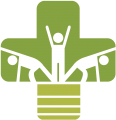We see lots of cyclist in the clinic who complain of a sore neck. Many cyclists believe it’s just part of getting on your bike for a long ride. But there is always a reason why you get neck pain or any other aches and pains whilst doing sport or an activity. Most likely this is because of the way you perform the activity. You can end up putting stress on the particular area or tissues. When you come in to see us in the clinic as a cyclist with pain I will always ask for a video of you cycling, taken from behind and the side, so that I can analyse your position and movement. Then we also address any other contributing factors (in the video below you can see a case study where the cyclist also has a stiff low back)
Still working from home or back in the office; top tips for good posture and avoiding aches and pains
1. Get your screen set up right
Make sure the top of the screen you use is at eye level. Raise it onto a flat top printer, books or a laptop holder so you aren’t slouching to read the screen. Sit your bottom right back in your seat so that your lower back is supported by the chair back rest. Your computer screen should be an arm’s length away from you.
2. Protect your shoulders and wrists
Try to use a separate keyboard and mouse when using a laptop. Position your keyboard close enough to keep wrists relaxed and straight and your elbow is bent at about a 90 degree angle
3. Don’t slump on the sofa
Avoid at all costs slumping on the sofa especially with your legs up when using iPads and laptops. This causes a lot of stress on the lower back and neck
4. Home set up for sitting
If you don’t have access to an office chair, adapt a kitchen chair by adding a cushion for height. Roll a towel up to make a lumbar support and place this horizontally in the small of your low back.
5. Support your feet
Supporting your feet helps you stay upright. Put your feet flat on the floor with your knees bent at a 90-100-degree angle.
6. Sharing desks and chairs at work
If you Share a desk with someone much taller or shorter than you, remember to adjust the screen, chair height and if needed bring a cushion to the office to support you back.
7. Listen to your body
Aches and pain are not a signal that you have damaged your body. It is usually just the body’s way of telling you to move from the posture you are in and try another one.
7. Keep moving
Have activity breaks every half hour for 1-2 minutes to avoid tension building up. Set reminders on your phone. Walk around when on the phone and walk up and down the stairs. Do some streches reaching your arms up towards the sky and some side bends.
9. Try standing for a while
Raise your work area using a pile of books on your kitchen work top, ironing board or tall chest of drawers, and stand for a while. We’ve had to ban my husband from working by the kitchen worktop as this was too near the fridge and toaster
10. Take some exercise
Take time away from your desk to take one hour of exercise per day outside where possible. Try not to eat at your desk whilst working.
Shoulder pain following vaccination
Over the last year or so we have been asked if having a vaccination can bring on shoulder pain or upper arm pain. I decided to have a look into this and found a great bit of research on the subject.
The quick answer is No. There is no evidence that injections in the deltoid muscle (upper arm muscle) sets of shoulder pain except for 2 very rare possibilities.
- The person injecting went right down to the bone and hit the periosteum, which is the membrane that surrounds the bone. This can bring on deep bone ache.
- The person injecting hit a nerve. You would know if this happens because you would get nerve pain and other symptoms like numbness or pins and needles.
The conclusion of the research is that if you do develop shoulder pain after vaccination this is most likely coincidental. If you are unlucky and this is the case for you it’s probably best to come in and have your shoulder/arm checked out.
Getting back in to exercise post-COVID
An interesting broadcast about getting back in to exercise when recovering from COVID-19, along with online physio to help stop falls, and how exercise has changed during the pandemic.https://www.bbc.co.uk/programmes/m000rlpj
Lower Limb Tendon Pain
This article highlights the 10 things you shouldn’t do if you have lower limb tendon pain. It’s always good to know the things you shouldn’t do, as well as the things you should!
http://semrc.blogs.latrobe.edu.au/10-things-not-to-do-if-you-have-lower-limb-tendon-pain/
ACL Rehabilitation
If you’ve suffered an ACL injury then this is a really useful resource which details what to expect and what to consider when embarking on your rehabilitation journey. It is well worth a read.
5th January 2021: Covid-19 Update
We are still open for business!
All of our physios are still working and are offering face-to-face consultations as normal. If you are not comfortable being seen face-to-face we can offer the choice of a video (via Zoom) or a phone consultation. This means that we are still able to offer advice and exercise guidance to help get you moving again and reduce pain levels during these difficult times. If needed, we can also send out exercise bands and other physiotherapy appliances as required.
If you would like an appointment, please call the office on 01892 785095.
Welcome to our new website!
Please take a moment to look around out great new website.
